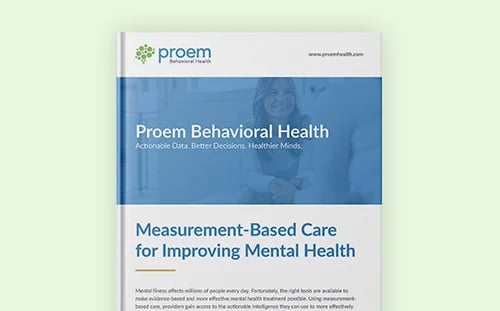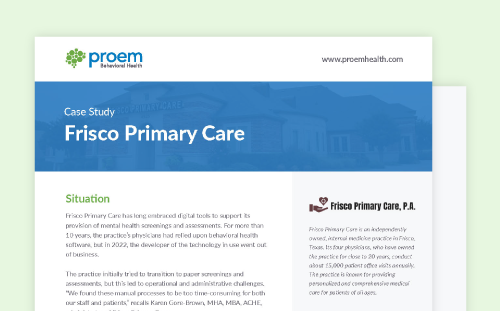In 2022, the National Institute of Mental Health estimated that over one-fifth of Americans ages 18 and older — approximately 23% — live with a mental illness. These disorders influence not only a person’s emotional well-being, but also their ability to perform day-to-day activities. Symptoms may interfere with work performance, strain relationships, and interfere with family and home life.
Unfortunately, most standard mental health assessment tools focus solely on symptom severity rather than a condition’s broader effects on a patient’s daily functioning — overlooking the importance of whole-person care, which is a comprehensive approach to improving outcomes that considers all aspects of a patient’s health and the biological, social, behavioral and environmental factors that influence the onset of disease.
The Sheehan Disability Scale (SDS), however, offers a structured way to assess the functional consequences of mental health disorders across a person’s professional and personal life. Let's explore how the SDS helps mental health providers review patients’ overall well-being, enhance treatment plans and improve outcomes.
What the Sheehan Disability Scale Looks At
Mental health disorders have far-reaching impacts on a patient’s daily life because they often disrupt the habits and routines that are essential to functioning in a positive, healthy way. For example, individuals may practice poor sleep hygiene that leads to too much or too little sleep, eat poorly, avoid exercise, or become dependent on illicit substances.
Among popular mental health assessment tools, the Sheehan Disability Scale is unique because it helps providers understand the extent to which patients’ symptoms and changes in behavior have destabilized different areas of their life. These insights can not only help providers see the full scope of the impairments but also refine care plans and bolster the delivery of better whole-person care.
The Sheehan Disability Scale examines these three measures:
The Impact of Mental Health Disorders on Work or School Performance
For many patients, mental health disorders have a substantial influence on their work or academic performance. They may have trouble concentrating, making decisions and completing tasks efficiently, which can lower their productivity and raise the ire of their peers, teachers or leaders, exacerbating existing stress and negative feelings. They may struggle with relationships and communication in these settings and miss days, which can lead to isolation and, for professionals, financial stress.
The Sheehan Disability Scale helps clinicians evaluate the extent to which these challenges threaten a patient’s ability to maintain employment or keep up with academic demands.
The Impact of Mental Health Disorders on Social Life
Mental health patients may experience trouble expressing their feelings, struggle with emotional regulation and withdraw from friendships, making it difficult to maintain close connections. For example, patients with mood disorders can have outbursts, irritability or difficulty managing stress, which can keep people at a distance. Someone with anxiety may desire but avoid social interactions, worsening loneliness and low self-esteem that perpetuates cycles of disengagement.
The Sheehan Disability Scale assesses how much symptoms have affected a patient’s social life, relationships and leisure activities, and paves the way for tailoring treatment to their specific needs.
The Impact of Mental Health Disorders on Home Life
Individuals with mental health conditions may also grapple with strained or neglected family relationships and household stress. Cognitive difficulties like executive dysfunction can lead to disorganization, poor time management and difficulty completing household chores. Severe symptoms of depression may create emotional distance and conflict between family members or confuse children when the patient is a parent. Meanwhile, increased medical expenses for therapy and medication can add to financial strain.
The Sheehan Disability Scale provides information that helps clinicians find solutions and communication strategies to improve how patients function at home.
How the Sheehan Disability Scale Works
The SDS is a simple yet powerful mental health assessment tool to help clinicians quantify the impact of mental health disorders on daily life. Using a scale from zero (no impairment) to 10 (severe impairment), patients rate how mental health symptoms affect their work or school performance, social life, and family and home responsibilities.
The total SDS score, which ranges from zero to 30, provides a quantifiable measurement of overall functional disability, with higher scores indicating more severe impairment.
Using the Scale to Enhance Mental Health and Whole-Person Care
By administering the SDS at multiple points throughout treatment, mental health providers can record key information crucial to improving whole-person care delivery, enabling the patient’s broader team to have discussions about their ongoing well-being beyond a diagnosis.
The scale also supports clinical trials and psychiatric treatment plans by tracking the effectiveness of various interventions, such as medications, therapy approaches or lifestyle modifications. By comparing pre- and post-treatment SDS scores, providers can determine which strategies yield the most meaningful improvements.
Incorporate the SDS Into Your Practice
The Sheehan Disability Scale helps clinicians deliver whole-person care and improve the real-world impact of their treatment plans. Through Proem, mental health care providers and clinical researchers can license the SDS and other mental health assessment tools to accurately evaluate the impact of mental health disorders. See our behavioral health tools or contact us to learn more.





.png)







